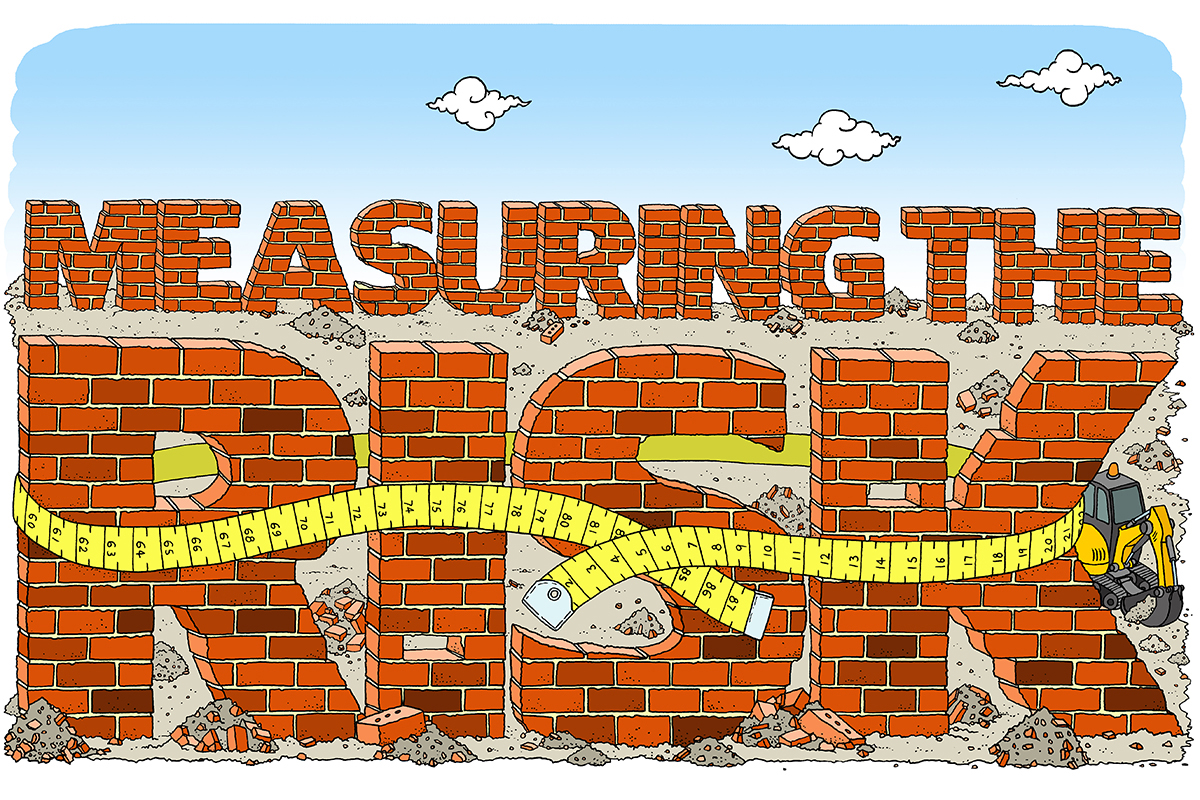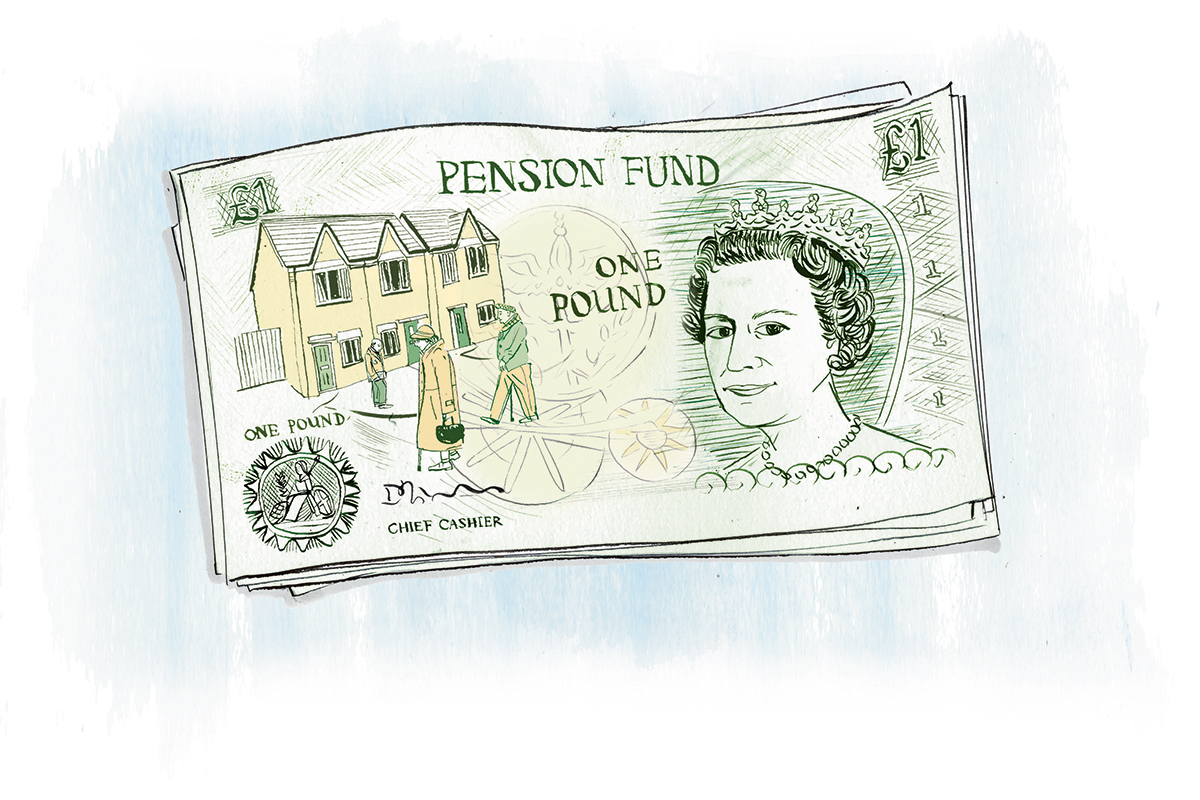You are viewing 1 of your 1 free articles
Measuring the risk: why the English regulator is 'regrading' landlords
As the Regulator of Social Housing ‘regrades’ a number of landlords, Gavriel Hollander looks at the reasons why Illustration by Andy Council
Jonathan Walters is categorical in his assessment of how to view the recent spate of regulatory downgrades across the housing association sector. “It’s pretty black and white,” the deputy director of strategy and performance at the Regulator of Social Housing (RSH) tells Inside Housing. “Either you’re viable or you’re not.”
In the not-too-distant past, a housing association being told that it was facing a change to either its governance or viability rating would have been the cause for at least mild panic. But the regulator has been brandishing its Tipp-Ex on a far more regular basis over the past six months.
Since last September, 19 housing associations have had their viability rating changed from V1 to V2 (see table below). The regulator is keen to classify these alterations as ‘regrades’ rather than downgrades. This isn’t just an example of Orwellian newspeak designed to sweeten the pill; language in this instance is important.
Writing for Inside Housing’s sister title Social Housing last November, Fiona MacGregor, executive director of regulation at the RSH, echoed her colleague’s point. She wrote: “Let’s be clear at the outset. V1 and V2 are both compliant grades, and a wide range of organisations could fall into each category.”
Which is all well and good, but there is no guarantee that the words of the regulator will fall on open ears when housing association boards are told that they can no longer lay claim to the gold standard when it comes to financial viability.
So what should housing associations understand about the new regulatory climate and how have they reacted so far?
At this point, a brief history lesson is helpful. Back in the distant days before the credit crunch and the disappearance of social housing grant, around 30% of associations were rated at V2 or the equivalent, according to Mr Walters. In the heat of the financial crisis that followed in 2008, that proportion increased to nearly half of the sector.
Then, something odd happened, as Mr Walters explains: “In that period after the credit crunch, the economic environment for housing associations was pretty positive and we saw the number of V2s dropping.”
That positive environment – in which low interest rates led to historically cheap funding suddenly becoming available to social landlords – meant that the more ambitious in the sector began to take on more risk. Since then, the idea of cross-subsidising social and affordable housing delivery through more market-facing activity has become mainstream, transforming the sector’s attitude when it comes to risk.
Recent regulatory ’regrades’
| Publication date | Provider | Governance rating | Viability rating | Explanation |
| 27/09/17 | Network Homes | G1 | V2 | Viability regrade: V1 to V2 |
| 25/10/17 | Unity Housing Association | G2 | V2 | Governance downgrade and viability regrade: V1 to V2 |
| 15/11/17 | Acis Group | G1 | V2 | Viability regrade: V1 to V2 |
| 15/11/17 | Christian Action (Enfield) HA | G1 | V2 | Viability regrade: V1 to V2 |
| 15/11/17 | East End Homes | G1 | V2 | Viability regrade: V1 to V2 |
| 15/11/17 | Eden Housing Association | G1 | V2 | Viability regrade: V1 to V2 |
| 15/11/17 | Green Square Group | G1 | V2 | Viability regrade: V1 to V2 |
| 15/11/17 | Hyde Housing Association | G1 | V2 | Viability regrade: V1 to V2 |
| 15/11/17 | Manningham HA | G3 | V2 | Viability regrade: V1 to V2 |
| 15/11/17 | Peabody Trust | G1 | V2 | Viability regrade: V1 to V2 |
| 15/11/17 | The Wrekin Housing Group | G2 | V2 | Viability regrade: V1 to V2 |
| 29/11/17 | Broadland Housing Association | G1 | V2 | Viability regrade: V1 to V2 |
| 29/11/17 | Orbit Group | G1 | V2 | Viability regrade: V1 to V2 |
| 29/11/17 | Thrive Homes | G1 | V2 | Viability regrade: V1 to V2 |
| 31/01/18 | Cambridge Housing Society | G1 | V2 | Viability regrade: V1 to V2 |
| 31/01/08 | Connexus Housing | G1 | V2 | Viability regrade: V1 to V2 |
| 31/01/18 | First Choice Homes Oldham | G1 | V2 | Viability regrade: V1 to V2 |
| 31/01/18 | Nehemiah United Churches HA | G1 | V2 | Viability regrade: V1 to V2 |
| 01/02/18 | Suffolk Housing Society | G3 | V2 | Governance downgrade and viability regrade: V1 to V2 |
“We’re not far from the historical long-run norm,” says Mr Walters when asked about what the higher-than-usual number of ‘regrades’ has done to the proportion of V2 associations.
“We knew this was coming, which is why we trailed it in advance,” he adds. “We knew this was where the sector’s risk profile would take it.”
But if the message from the regulator is very much “don’t panic”, has it been heard?
Critically, while 19 associations have been regraded since September – and there are likely to be more, with Ms MacGregor suggesting the number of V2s across the sector will increase by 50% – only two of these have suffered contemporaneous governance downgrades: Unity Housing Association and Suffolk Housing Society. Between them, these landlords account for just 3,500 homes.
The regulator insists that, while it is – in Mr Walters’ words – “relaxed about people being on V2 indefinitely”, it is far from sanguine about G2 ratings when it comes to governance. Any association assessed as G2 needs to assure the regulator it has a plan in place to get back to G1, irrespective of its viability grading. On that point, there has been no movement from the regulator.
Landlords understand this well. As Michael Newey, chief executive of Broadland Housing Association, puts it: “If you get governance wrong, other things start going wrong as well, so G1 is absolutely important to us.”
Broadland was regraded from V1 to V2 in November. Like a number of its peers that now sit on a V2 rating, the landlord has upped its development ambitions and is diversifying by starting a market sale programme. The association wants to build 600 homes over a three-and-a-half-year period, partly subsidised through the development of 200 market sale homes. For an organisation that currently manages 5,000 homes, these are ambitious growth plans.
“We recognise that we were always going to have a conversation with the regulator about market sale and whether we had the right skills and experience and the right governance structures in place to manage that programme,” Mr Newey explains.
“What was really important to us was retaining the G1 rating. We felt we had a really strong board and a strong structure in the organisation to enable us to develop the market sale portfolio appropriately.”
Broadland is in the process of negotiating a private placement of £50m to fund its development programme, so Mr Newey and his finance team are ideally placed to answer one of the nagging questions brought up by the viability regrades: what do funders think?
“V1 and V2 are both complaint grades, and a wide range of organisations could fall into each category.” - Fiona MacGregor, executive director, RSH
The chief executive says that there is “an understanding among investors about what the viability rating means”. On a January roadshow ahead of the private placement, Broadland saw eight investors in two days, suggesting appetite for the housing association’s debt is still there. And while Mr Newey will not be drawn on pricing at the time of writing, he insists that it has come in well below the “worst-case scenario” outlined in the association’s business plan.
Indeed, finance directors on the whole seem to share the view that investors are as relaxed as the regulator about V2 associations.
When asked what the impact has been in terms of funding, the financial director of another V2 association, who does not want to be named, answers: “None at all.”
“It hasn’t changed the accessibility to funds, except at the fringe,” they elaborate. “Some newer lenders, like HSBC, would only go to G1/V1 [associations] but that’s a function of them just coming into the sector.
More experienced funders will price debt about the same for V1 and V2-rated associations. They say: “Maybe there’s a couple of basis points in it.”
The exact reasons for being graded V2 are almost as numerous as the type of housing association. Broadly, however, landlords will be V2 because they are involved in more risky market-facing activity, they have upped their development pipeline, or they are servicing significant amounts of debt.
For some, it’s a reflection of changes beyond their control. “They may not actually be sailing any closer to the wind,” explains a source with links to the regulator. “But the economic environment is more hazardous than it was before, with the rent cut, Universal Credit, and more commercial tenures in business plans.”
However, the source points out that most of the “financially strongest” associations are also still V1. This may seem like an obvious point, but it also appears that many of the biggest developers are also V1. In fact, of the 19 that have been regraded to V2 since September, only four feature in Inside Housing’s ranking of the 50 landlords with the largest development pipelines.
One of those, The Wrekin Housing Trust, is also rated G2 on governance, having been downgraded in November 2016. Francis Best, its director of finance, explains that, as a large-scale voluntary transfer which by definition has high levels of historic debt, the association will “require additional funds through refinancing” to continue its development prgramme. That programme accounted for more than 600 additional homes in 2016/17, with a further 700 anticipated for 2017/18.
“Board members, especially when they don’t have a sector background, would see any regulatory drop as negative.” - Francis Best, The Wrekin Housing Trust
Following the regrade, Mr Best admits that “it will be for the board to now reassess its risk appetite for the continued delivery of new affordable homes” in the wake of the regulator’s decision.
Therein lies one potential sticking point in the new regulatory environment: even if executive teams and investors are relatively unmoved, does the same apply to housing association boards? Might they be a little more worried about a regrade than their chief executives, for example?
“I think that they probably would,” agrees the unnamed finance director. “Board members, especially when they don’t have a sector background, would see any regulatory drop as negative.”
However, the director says his association “expects to be on V2 for a number of years” and that its board is comfortable with the situation.
Hyde Housing Association is the only G15 member to have been regraded to V2 in recent months. Peter Denton, its finance director, is as understanding as his peers that the regrade is, in part, a consequence of development risk. “It’s tautological to say that if you are developing houses, you’re taking risk,” he reasons.
“It would be helpful if the regulator firstly helped us understand how they’ve derived that analysis," Peter Denton, Hyde Housing
However, he thinks communication from the regulator would help the subsequent conversations that take place to ease the concerns of more cautious board members.
“It would be helpful if the regulator firstly helped us understand how they’ve derived that analysis,” he elaborates. “Imagine a chair or board member of a housing association asking: ‘We are now V2, if we wanted to how can we get back to V1?’
“I would probably be able to respond if it were the [ratings agencies] Moody’s or Standard & Poor’s methodology. But here I would say to the regulator: ‘Help us understand in what way you’ve determined our ratings to enable us to be clear of all options with our board.’”
One finance director categorises the reaction to regrades in three ways: those that see it as a “badge of honour”, those that understand the rationale and are “quite happy about it”, and those that view V1 as something to maintain, an attitude which they see as “the wrong view”.
At the regulator, Mr Walters makes the point in a more subtle way: “Our message is don’t be ashamed of being V2,” he concludes. “If you want to have less risk in your business, that’s up to you as an organisation. But it would be a real shame if everyone was changing their business plans because of a viability rating from the regulator.”














